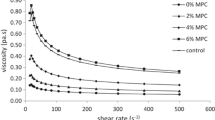Abstract
A study was carried out to determine the effects of use of rape seed oil in the production of ice cream. The basic ice cream, i.e., control (C) had 4.5% milk fat, 11.75% MSNF, 1.25% whey protein concentrate-70 (WPC-70), 15% sucrose, 0.2% sodium alginate, and 0.2% glycerol monostearate with a total solids content of 32.9%, vanilla flavored ice cream was prepared by partially replacing milk fat with rape seed oil. The rape seed oil was incorporated at three different levels, i.e., F1 (1% palm olein and 3.5% milk fat), F2 (2% rape seed oil and 2.5% milk fat) and F3 (3% rape seed oil and 1.5% milk fat), in mix formulation, other ingredients were same as that of basic ice cream mix (C). The effect of addition of rape seed oil on physico-chemical and sensory characteristics of ice cream was determined. Incorporation of rape seed oil at F3 level did not have any adverse effect on the compositional attributes, pH and acidity of ice cream, flavor and melting quality scores and total score.
Similar content being viewed by others
References
Abdou SM, Montasser EA, Younis HA (1996) Evaluation of some dairy blends for dietetic ice cream. Egypt J Dairy Sci 24:103–114
Adhikari K, Arora KA (1994) Development of mellorine type frozen desserts: 1. Effect of stabilizers and emulsifiers. Indian J Anim Sci 64:526–533
BIS (1989) Hand book of food analysis, part XI, dairy products. Bureau of Indian Standards, Manak Bhavan
Bodyfield FW, Tobias J, Trout GM (1988) Sensory evaluation of dairy products. AVI Publications, New York
Cornell J (1991) Ice cream and frozen confectionary. Cited from Berger, Dec/Jan, pp 139–144
Flack E (1988) Factors which Influence the melting properties of ice cream. Ice cream and Frozen Confectionery, vol 39, p 232
ISI (1971) Guide for sensory evaluation of foods. Part I: optimum requirements. IS: 6273. Bureau of Indian Standards, Manak Bhavan
ISI (1961) Methods of test of dairy industry. Part II: chemical analysis of milk. IS: 1479. Bureau of Indian Standards, Manak Bhavan
Krauss RM, Eckel RH, Howard B (2000) American Heart Associations Dietary Guidelines review, Healthcare Professionals from Nutrition for Committee of the American Heart Association. Circulation 102:2284–2289
Kumar R (2004) Ecstasy and celebration of life called ice cream. Indian Dairyman, vol 56, pp 43–47
Laboratory Manual (1959) Methods of analysis of milk and milk products, 3rd edn. Milk Industry Foundation, Washington
Ling ER (1963) Textbook of dairy chemistry practical, 3rd edn. Chapman and Hall, London
Lowenstein M, Haddad GS (1972) High temperature pasteurization of ice cream. Part I: the effect of various heat treatments on the solubility of the components. Am Dairy Rev 34:82
Marshall RT, Goff RD, Hartel RW (2003) Ice cream, 6th edn. Kluwar /Plenum Publication, New York
Mathur MP, Datta RD, Dinakar P (1999) Text book of dairy chemistry. ICAR, New Delhi
Menefee SG, Overman OR (1940) Semi micro Kjeldhal method for determination of total nitrogen in milk. J Dairy Sci 23:1177–1185
Miglani N, Jain SC, Shukla PC (1987) Studies on the technology of partially filled ice cream using buffalo milk and vegetable oils. Beverage Food World 14:19–25
Neshawy EAA, Abdel BA, Rabie AM, Metwally AS (1989) Organoleptic and physical properties of ice cream made from hydrolysed lactose reconstituted milk. Food Chem 27:83–86
Rabie AM, AlNeshway AA, Adbel Baky AA, Metwally SA (1987) Effect of replacing milk fat by vegetable oils on some properties of ice cream. Egyptian J Appl Sci 3:461–465
Rodriguez T, Otero M, Camejo J, Banguela S (1991) Utilization of vegetable fat in ice cream. Alimentaria 228:45–47
Sommer HH (1951) Theory and practice of ice cream making, 6th edn. Olson Pub., Milkwankee
Steel RGD, Torrie JH (1980) Principles and procedures of statistics. A biometrical approach, 2nd edn. McGraw Hill Kogakusha Ltd, Japan
Tong JH (1984) Use of sunflower oil in ice cream. J Dairy Sci 67:779–783
Upadhyay KG, Patel AR, Vyas SH (1978) Evaluation of Isabgul (Psyllium) husk and gum accacia as ice cream stablizers. Gujarat Agr Res J 4:87–88
USDAH (2000) U.S Dept. Agri. and Dept of Health Human Services Dietery guidelines for Americans. 5th edn. Home and Garden Bull. No. 232, p.112
Conflict of interest
None.
Author information
Authors and Affiliations
Corresponding author
About this article
Cite this article
Nadeem, M., Abdullah, M. & Ellahi, M.Y. Effect of incorporating rape seed oil on quality of ice cream. Mediterr J Nutr Metab 3, 121–126 (2010). https://doi.org/10.1007/s12349-010-0012-0
Received:
Accepted:
Published:
Issue Date:
DOI: https://doi.org/10.1007/s12349-010-0012-0



